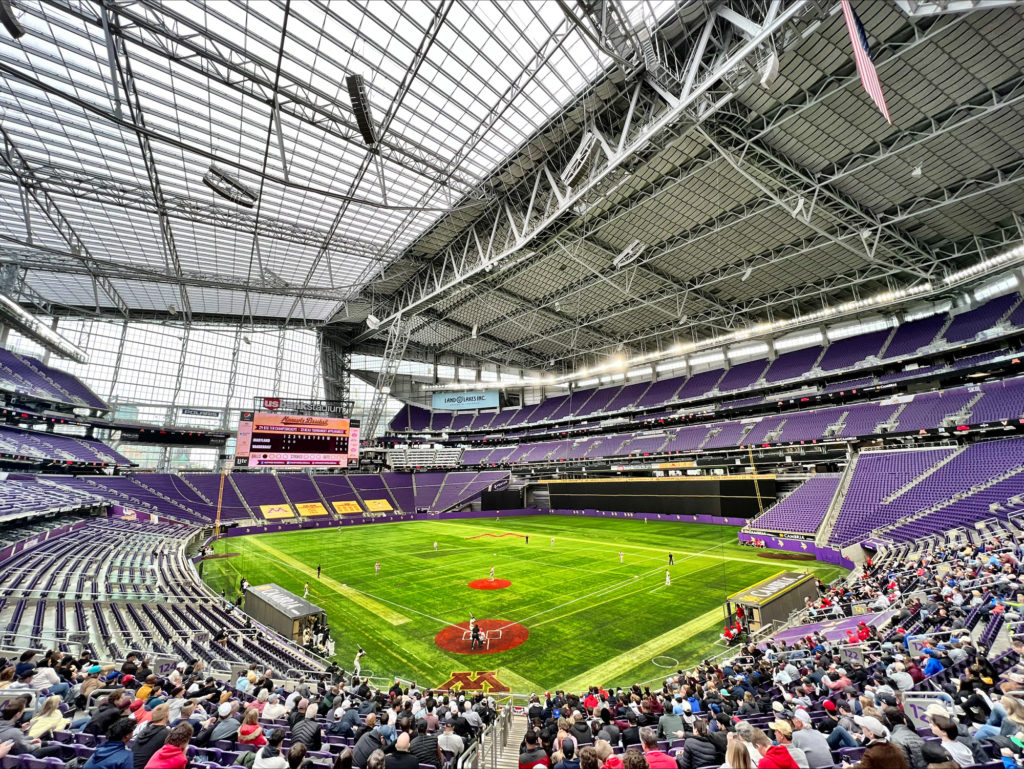
Forget the conventional wisdom that multiuse baseball/football facilities totally died out after 1989 when SkyDome opened. Welcome to U.S. Bank Stadium, home of the NFL’s Minnesota Vikings…and the spring home of the Minnesota Golden Gophers baseball team.
U.S. Bank Stadium opened in July 2016 as home of the Vikings—replacing a temporary home in TCF Bank Stadium (now Huntington Bank Stadium) and a longer-term home in the Metrodome—but March 7, 2017, saw the stadium’s inauguration as Gophers home base when it’s too cold to play at the team’s on-campus Siebert Field. The Gophers had also called the Metrodome home, either partially or fully, for many years before that.
In fact, the Metrodome was ground central for Minnesota baseball for decades before it was torn down: you’d see local colleges and high schools playing games around the clock when it was cold and snowy outside. When U.S. Bank Stadium was proposed to local governmental units, one part of the plan called for it to replace Metrodome as home to Minnesota baseball in late winter and early spring. Minnesotans are hardy, but not that hardy. So U.S. Bank Stadium was designed for both baseball and football.
The U.S. Bank Stadium baseball configuration borrows heavily from configurations for both the Vikings and Twins in the Metrodome days. Right-field seating retracts from the football configuration to create baseball space, yielding a huge, 34-foot-high wall—in the case of the Metrodome, a 23-foot-tall plastic “baggie”—and some unusual field measurements: 328 feet LF, 370 feet LC, 381LC, 400 feet C, 365 feet RF. No dugouts were designed in the football configuration; instead, shipping containers modified with chain-link barriers (protecting players) are hauled onto the field and removed as needed. Seating is limited to 10 sections behind home plate and down the first-base line, behind the minimal netting. Two concession stands serve the hungry public with stadium staples—hamburgers, hot dogs, fries, chicken tenders—in one and beverages, including beer and mixed drinks in the other.
U.S. Bank Stadium features a reverse-Tardis design—the seating bowl feels smaller in the inside than it looks from the outside, in a design dominated by abstract ship bow—but the many different seating sections make it useful and interesting in hosting events of all sorts, not just baseball.
 Technically, of course, the U.S. Bank configuration falls under the rubric of a multuse stadium originally implemented in DC Stadium (later RFK Stadium, now in the midst of demolition), but patented in 1960 by Shea Stadium designer John Waterbury of the Praeger/Kavanaugh/Waterbury architecture firm, comprising configurable seating sections based on event. Now, we’re not suggesting that multi-use facilities made a comeback based on the U.S. Bank design. Multiuse sports facilities encompassing MLB ballparks were pretty much dead after the retro movement and the opening of SkyDome. (Clarifying point: cookie-cutter stadia were all multiuse, but not all multiuse stadiums were cookie cutters. The Metrodome is evidence of that.)
Technically, of course, the U.S. Bank configuration falls under the rubric of a multuse stadium originally implemented in DC Stadium (later RFK Stadium, now in the midst of demolition), but patented in 1960 by Shea Stadium designer John Waterbury of the Praeger/Kavanaugh/Waterbury architecture firm, comprising configurable seating sections based on event. Now, we’re not suggesting that multi-use facilities made a comeback based on the U.S. Bank design. Multiuse sports facilities encompassing MLB ballparks were pretty much dead after the retro movement and the opening of SkyDome. (Clarifying point: cookie-cutter stadia were all multiuse, but not all multiuse stadiums were cookie cutters. The Metrodome is evidence of that.)
And we’d hate seeing U.S. Bank Stadium hosting baseball for any length of time. As it stands, baseball at the Bank is nice little respite from the terrible weather, a compromise that allows us poor northern souls to pretend we’re actually outside watching America’s Pastime when, in reality it’s 20 degrees with a foot of snow on the ground outside. We’ll live with it.
This article originally appeared is the Ballpark Digest newsletter. Are you a subscriber? Sign up here!
